Acratech’s unique style of made-in-the-USA ball heads and other tripod heads have been on the market for many years, but they often fly under people’s radar, and I’m not sure why. Perhaps the skeletonized look of the heads is visually polarising (I think it looks badass!), but there’s a good reason: The heads have an almost unsurpassed capacity to weight ratio.
Looking at the Acratech ball head specifications table below, you’ll see there isn’t a head on there that weighs more than 1lb, yet their capacity extends up to 50lbs! To put that into perspective, the RRS BH-55, one of the most popular professional ball heads on the market, also has a capacity of 50lbs, but it weighs twice as much as Acratech’s top-of-the-line head. If you’re a wandering, travelling landscape photographer with an already heavy pack and a big tripod, cutting the weight of your ball head by half would be huge! I own the big beefy RRS BH-55 so I can attest to that.
So, the unique skeleton design has a purpose, and on top of that, many of the ball heads have a 3-in-1 design that allows them to be used as a panoramic head and a gimbal head. Again this is a considerable weight-saving feature that can mitigate the need to carry additional specific tripod heads in your bag. I’ll go into these features in more detail below, but hopefully, I now have your attention, and you’re ready to learn more about Acratech’s range of ball heads and tripod heads. Let’s get to it!
Table of Contents
Acratech Ball Head Specifications
In recent years Acratech has simplified its product offering because there used to be several confusingly similar models. The models in the table below are those that are now available. If you’re looking for models such as the GV, GV-2, and GP-s, these models are no longer available.
| Model | Capacity | Weight | Height | Length | Width | Base Diameter | Ball Diameter |
|---|---|---|---|---|---|---|---|
| Acratech GXP | 50lbs (22.6kg) | 1 lbs. (.45kg) | 4.2″ (106mm) | 3.62″ (92mm) | 3.17″ (81mm) | 2.375″ (60mm) | 1.5″ / 3.81 cm |
| Acratech GXP-SS | 35lbs (15.87kg) | 0.85 lbs (.39kg) | 3.7″ (94mm) | Unknown | 2.9″ (74mm) | 2.1″(53 mm) | 1.5″ (38 mm) |
| Acratech GP | 25lbs (11.4kg) | .95 lbs (.43kg) | 4.14″ (105mm) | 3.47″ (88mm) | 3.20″ (81mm) | 2.375″ (60mm) | Unknown |
| Acratech GPSS | 25lbs (11.4kg) | 0.85lbs (0.38kg) | 3.71″ (94mm) | 3.52″ (89mm) | 2.9″ (73mm) | 2.08″ (53mm) | Unknown |
| Acratech Nomad | 25lbs (11.4kg) | .90 lbs. (.40kg) | 3.74″ (95mm) | 3.62″ (92mm) | 3.17″ (81mm) | 2.375″ (60mm) | Unknown |
| Acratech Ultimate | 25lbs (11.4kg) | .89 lbs (.40kg) | 4.1″ (104mm) | 3.1″ (79mm) | 3.06″ (78mm) | 2.375″ (60mm) | Unknown |
| Acratech Panoramic Head | 25lbs (11.4kg) | 0.94 lbs (.42kg) | 3.60″ (91.5 mm) | Unknown | 4.57″ (116.2 mm) | 2.375″ (60mm) | N/A |
| Acratech Long Lens Head | 25lbs (11.4kg) | .89 lbs (.40kg) | 3.63″ (92mm) | Unknown | 4.5″ (114.3mm) | 2.375″ (60mm) | N/A |
| Acratech Spherical Panoramic Head | 25lbs (11.4kg) | 1.0 lb (454 g) | Unknown | Unknown | Unknown | 2.0″ (50 mm) | N/A |
The 3-in-1 Head Design
Several of the heads I’m talking about share a 3-in-1 design, so I thought I would address that as a whole before I get into the individual models. The 3-in-1 design refers to using the head as a ball head, a panoramic head and a gimbal. Thereby significantly lightening your load if you’re someone that would usually travel with multiple heads. Or, as it is probably more likely, giving a photographer more features they otherwise would not have had because they would never have bothered to carry more than one head in the first place. The models with this 3-in-1 feature are the GP models: Acratech GXP and Acratech GXP-SS.
The first mode, ball head mode, needs no explanation, but I will point out that all the GP models have an individually controlled panning base, a ball friction control knob, and a locking knob. Now let’s take a look at the other two more unique modes of these heads:
Acratech Panoramic Head Mode
To take perfectly level panoramic images, simply leveling the ball on your tripod head isn’t enough to ensure a straight horizon; you also need to have a perfectly level rotation platform. Without a panoramic head, you need to perfectly level your tripod, which is a pain in the ass when you are dealing with three sets of extending legs.
Acratech solves this problem in their GP model heads by allowing you to quickly remove the clamp from the ball head and flip the whole thing upside down. Then you screw the clamp onto what was the base of the head. Now the rotation platform is above the ball, and this means that leveling the ball will give you a perfectly level rotation for your panoramas.
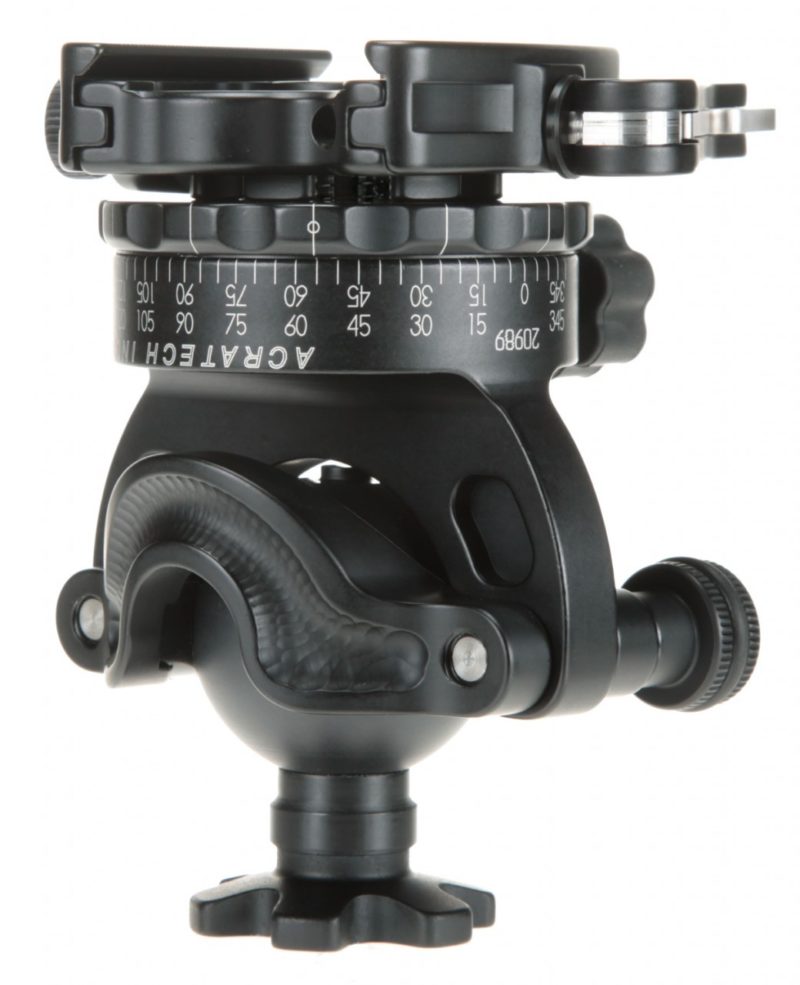
You might think, “well, I could do that with any ball head!” but you’d be wrong. Sure, you can often remove the clamp on a ball head, but the key here is that when you do so on the Acratech ball heads, you have a wide flat platform beneath it with a 3/8″ female hole.
Both things are necessary for this to work, and both items are generally not found on other heads. For example, if you remove the clamp on an RRS BH-55 or BH-40, you’ll find a 1/4″ 20 female hole on a thin neck with an anti-rotation notch cut into it. So it’s not flat, it’s not a broad platform, and the female hole is 1/4″20, not the necessary 3/8″. That’s the story for most ball heads, but not the Acratech ball heads.
The downside of this feature is that it requires you to carry a small hex key to remove the platform, but the change can be done in less than a minute. It’s also worth remembering that in this inverted panoramic mode, the head is perfectly capable of being used for non-panoramic images. So you don’t need to constantly switch the platform back and forth between shots if you aren’t consistently creating Panos.
Acratech Gimbal Mode
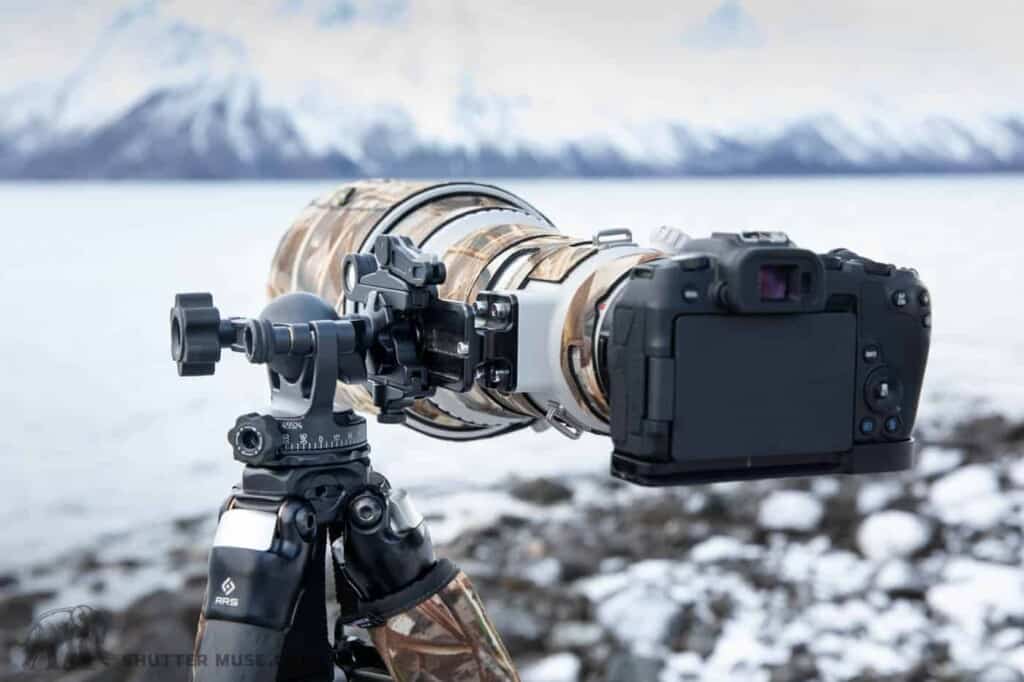
To use any of the GXP model ball heads in Gimbal Mode, flip the quick-release clamp 90 degrees into the drop-notch. When you do this, it locates a small pin on the base of the ball into a notch on the opposite side of the drop notch. You’ll also notice a step in the neck of the head that mates with a groove in the drop-notch.
These minor tweaks to a standard ball head design ensure a smooth and stable ball rotation, with the lens weight evenly distributed to both sides of the head. Of course, you’ll need to use a larger lens with a lens foot and an Arca plate on the foot.
Whilst this doesn’t deliver quite the same feeling as you might get when using one of the more traditional styles of gimbal from our gimbal head guide, it gets you a lot of the way there without having to buy (or carry) a second head. It’s a nice feature if you want to lighten your load!
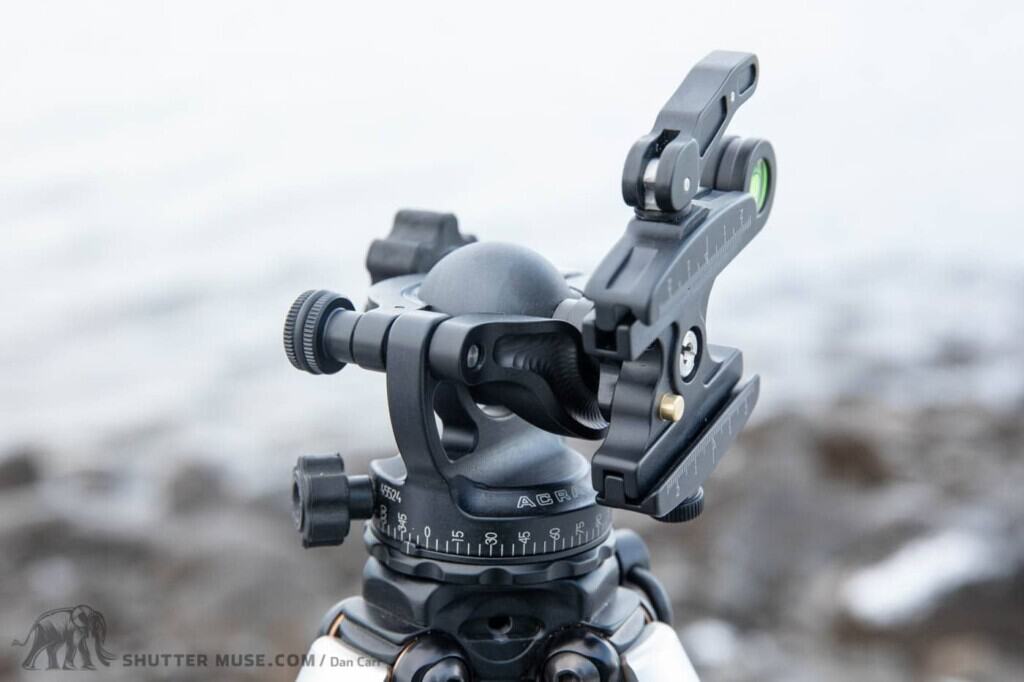
Acratech says that this feature is suitable for lenses up to a 400mm f/4, but that recommendation is quite vague and one they have used for many years. In more recent years, the big players have significantly decreased the weight of their larger lenses to the point where many 400mm f/2.8 lenses are several pounds lighter than they used to be, and I suspect with these newer lens designs, you can push that recommendation to include much longer focal lengths.
Most certainly, the gimbal feature can be used with popular lenses like a Canon 100-400mm, Canon 100-500mm, Nikon 200-500mm, Sony 200-600mm, Tamron/Sigma 150-600mm, Nikon 400mm f/4.5 and Nikon 800mm PF. I’d also include newer 400mm f/2.8 designs and some newer 500mm and 600mm lenses.
Much like the panoramic head feature, you might at first say, “I could do that with any ball head”, but the key here is the patented pin design on the bottom of the ball that helps to spread the weight of the lens to the opposite side of the ball head’s frame. This significantly reduces the neck’s friction in the drop-notch and results in a much smoother tilting motion than you would get from using any other ball head in this same way.
Also, because the head has been designed with this feature in mind, the movement and friction of the neck in the notch have been optimized by having a nice smooth U-shape at the bottom of the notch with that step in the neck. The whole function of the head in this gimbal mode is much better than using any other ball head in the same way because the entire thing was designed with this in mind.
Current Acratech Tripod Head Models
Acratech GXP
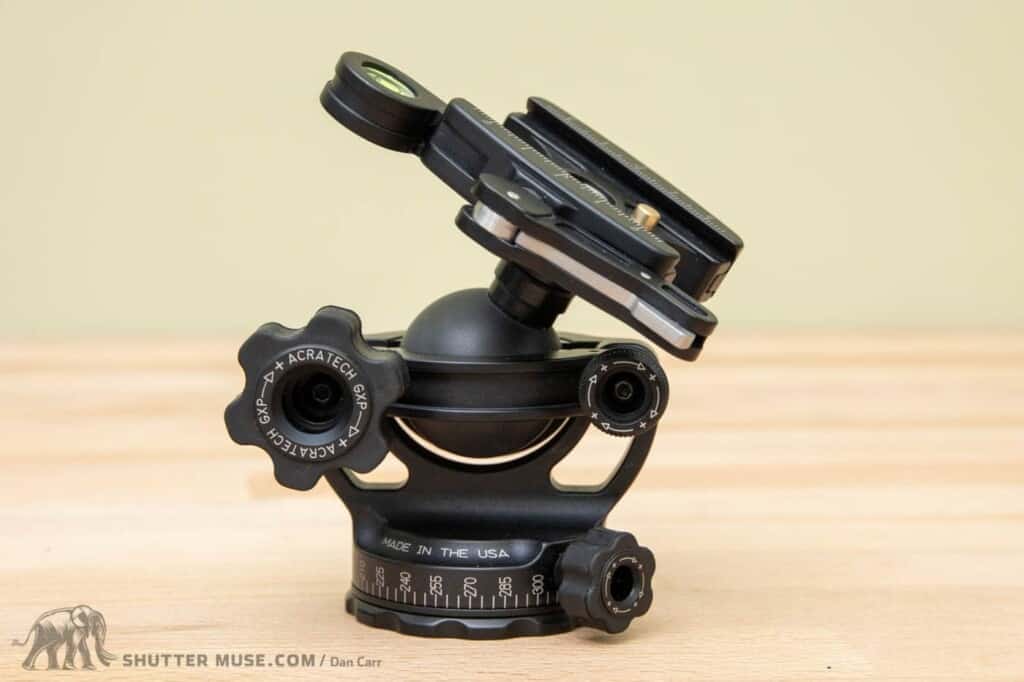
The GXP ball head is one of the newest of the Acratech heads. It takes the tried and true design of the previoius GP and doubles the capacity to a whopping 50lbs, whilst only weighing 1lb. This 50:1 capacity to weight ratio is something you really won’t find anywhere else on the market.
What I also find impressive about this head is that it’s only 0.05lbs heavier than the smaller GP model yet manages to have twice the capacity!
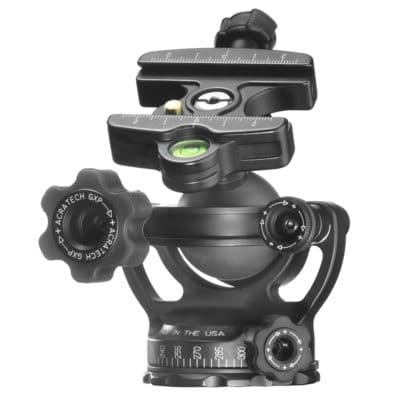
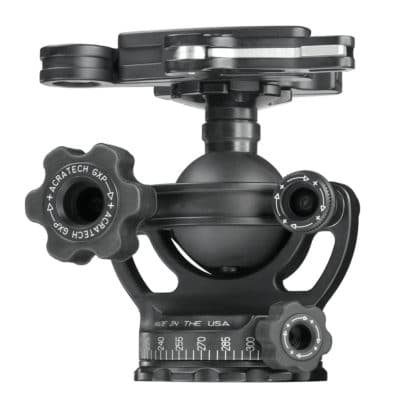
On the face of those specifications alone, you might be forgiven for thinking that choosing the GXP over the GP is a no-brainer. But the physical dimensions of these two heads are quite different, with the GP being much smaller. If you value packability, then the GXP might not be the head for you. Still, if your head spends most of its time on your tripod, strapped to the outside of your bag, this larger size isn’t likely to make a lot of difference to you, and you won’t notice the paltry 0.05lb weight increase. In that case, I would pick the new GXP. UPDATE: The GP has since been discontinued and the GXP takes its place in the lineup.
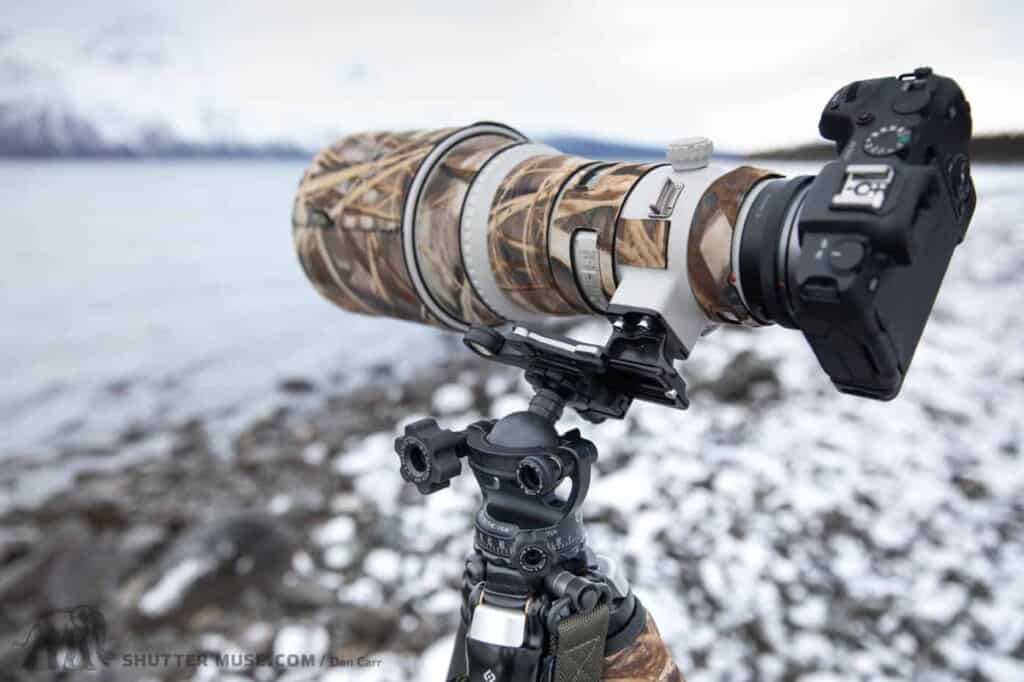
The GXP also has several updated features over the GP. While they are aesthetically similar, the GXP features markings on the knobs, which are not present on the GP. The lever-release clamp has also been redesigned to accommodate a larger range of quick-release plates. It includes a safety zone whereby the first 25% of movement on the lever doesn’t open the clamp jaws to prevent accidental release. The bubble level on the clamp has also been shifted to a position that makes it easier to view when a camera is attached to the head.
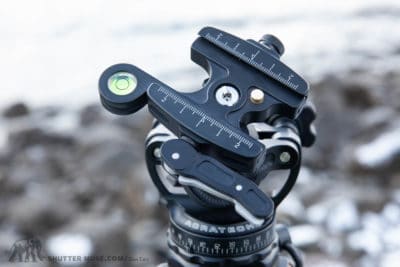
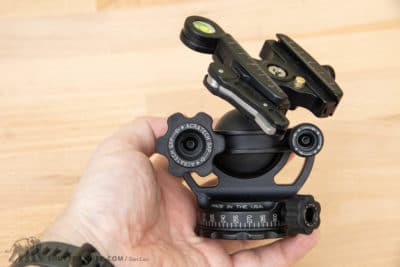
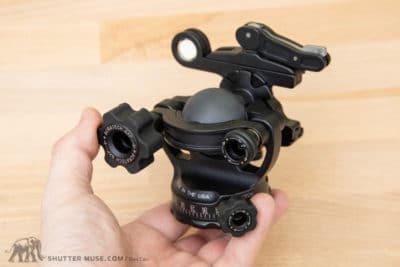
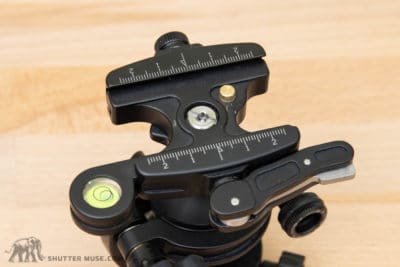
There’s no doubt that the new GXP is the king of the Acratech lineup, and I expect it to be the head that most people will choose, based on the new features and the incredible capacity-to-weight ratio. This incredible head has a considerable capacity and many features, backed by a 10-year warranty. Hard to find fault with that! If you want to read more about it, check out my Acratech GXP review.
Acratech GXP-SS
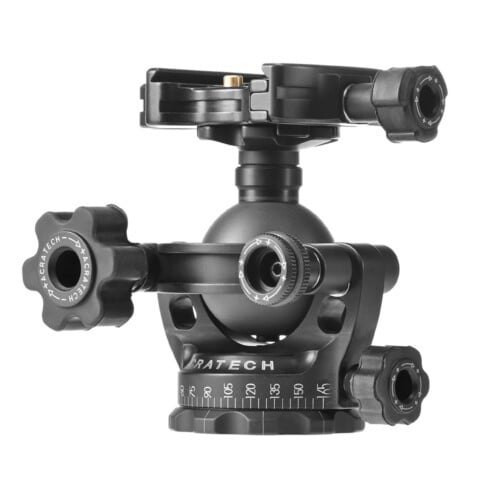
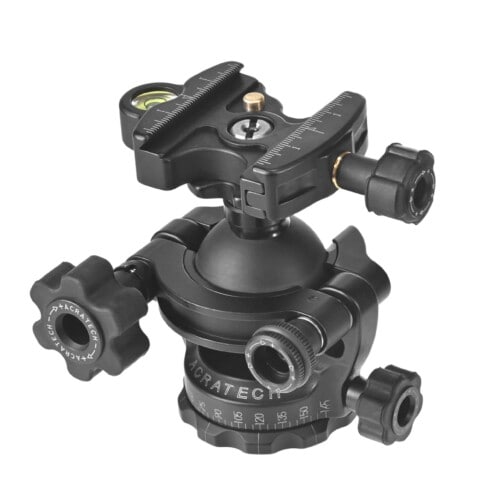
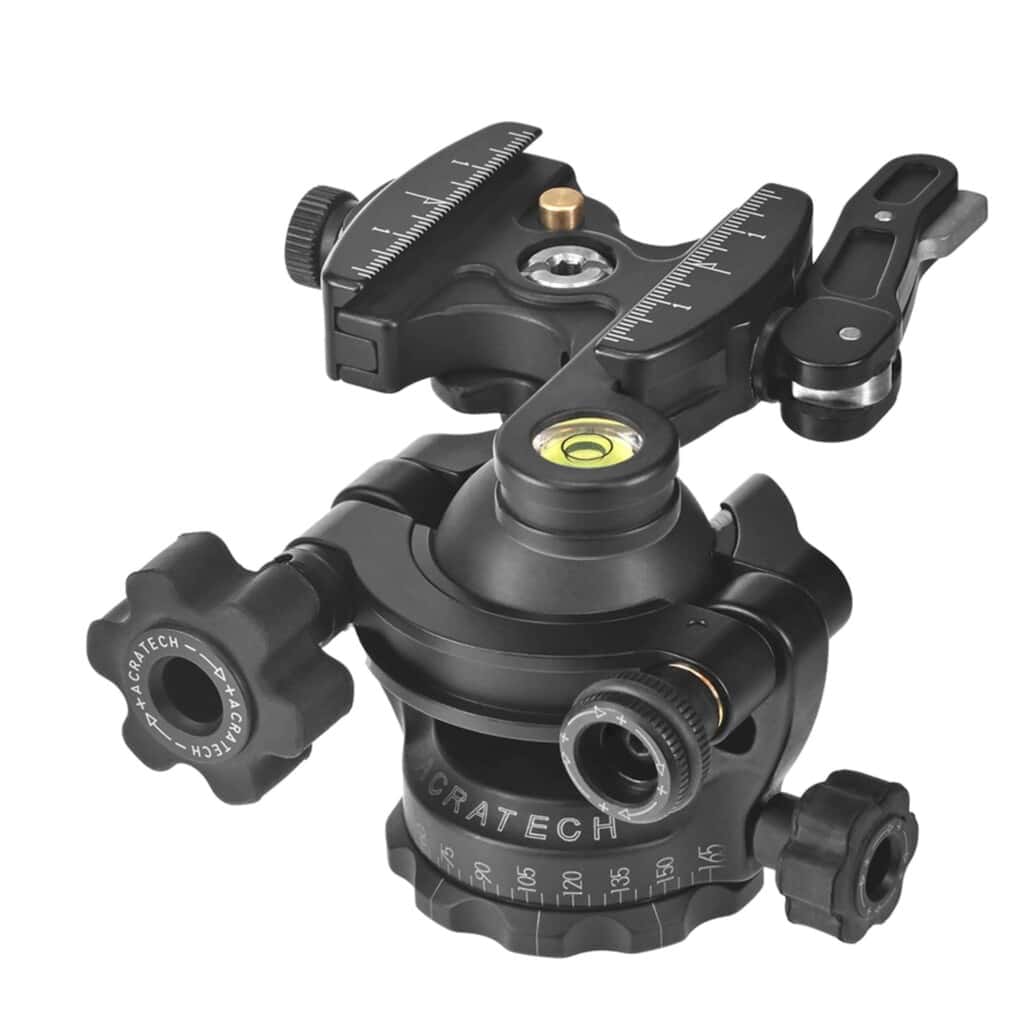
The Acratech GXP-SS takes the updated features from the popular Acratech GXP and combines them with the smaller size of the now-discontinued GP-SS model. The result is a miniature version of the GXP head that still has 35lb capacity while shaving 0.15lbs (60g) off the weight of its bigger brother. This creates an impressive capacity-to-weight ratio of 40:1.
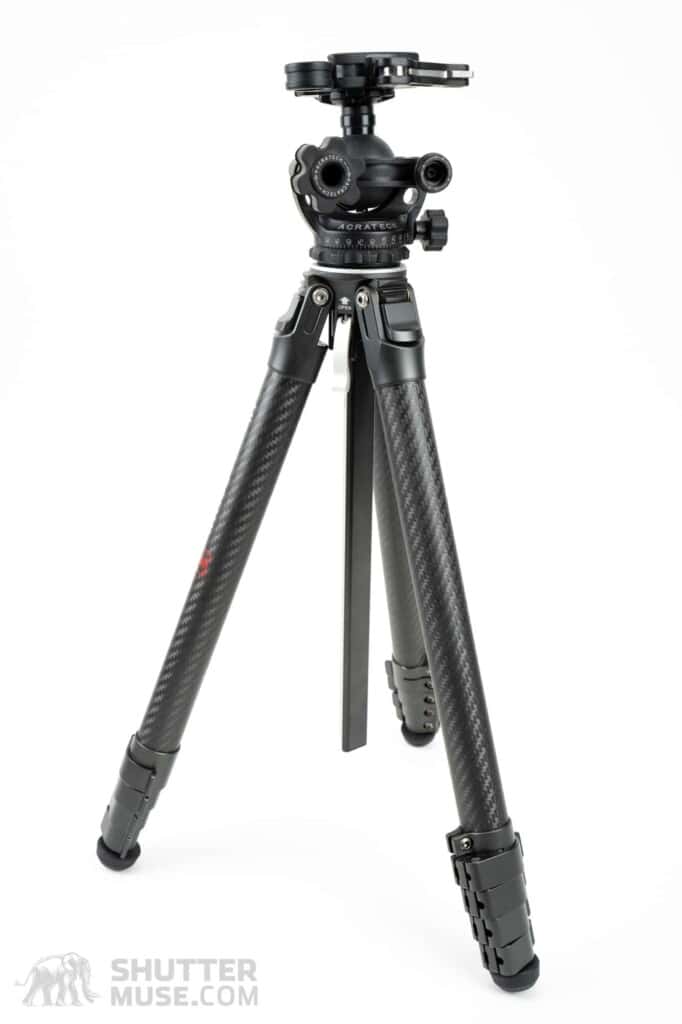
The smaller size of the GXP-SS ball head makes it perfect for travel tripods, and the lighter weight makes it an excellent option for landscape photographers that want to hike to their scenic locations. A 60g weight saving might not seem much, but every gram counts! The large 35lb capacity will still be more than enough for any camera and lens combination on the market, so there is a little sacrifice when choosing this new smaller version of the GXP.
Acratech Ultimate Ball Head
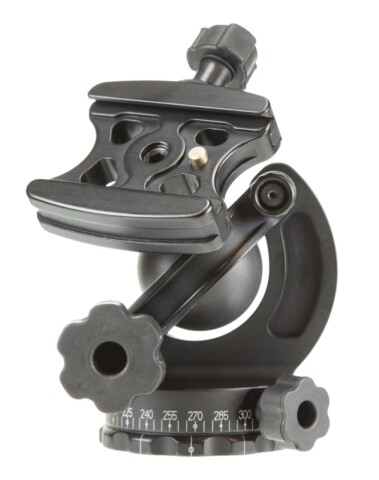
The name of the Acratech Ultimate head is misleading, and I wish they would change it to something more representative of its function and place in the lineup. A more appropriate name would be the Acratech Macro Head or the GP-Macro. When you see the word “ultimate”, you would imagine this to be the most feature-rich head in the lineup and likely the most expensive. Neither of those things is true. This is a ball head designed for macro photography.
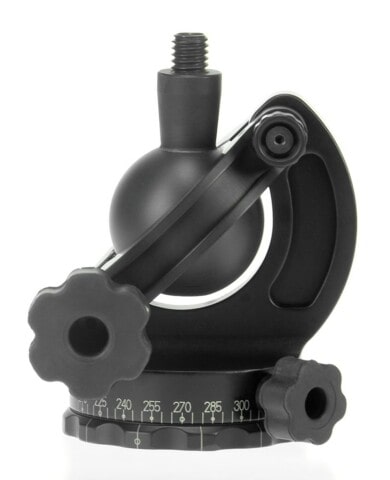
As you can see in the photo, the clamping system that holds the ball on the Ultimate head is tilted 45 degrees forwards. This means that the majority of the range of movement for the ball is in the forward direction, while you lose movement in the rearward “up” direction.
For general purpose usage, this would not be a good head to own, and I can’t imagine they sell all that many of them. Still, it does have some merit for those who like to do a lot of flower and macro photography for subjects usually in front and below your tripod.
With regular Acratech ball heads, a large downward tilt is only possible when positioning a drop-notch in the right place, and then your movement is limited within the notch unless you are also moving the panning base at the same time. If you find that is an issue with your macro or flower work, this head could be right for you. For everyone else, you’re much better off with any of the other previous four heads discussed in this guide.
Acratech Panoramic Head
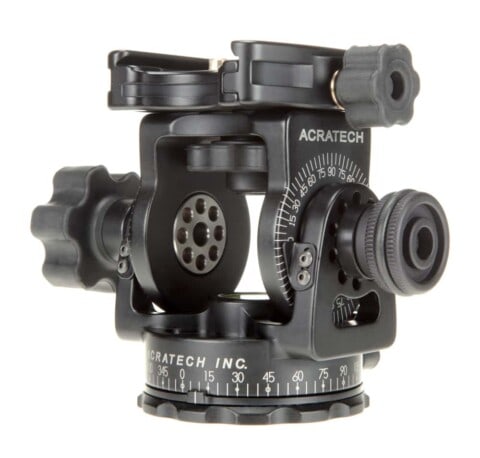
The Acratech Panoramic Head is called a tilt head, or a 2-way head, not a ball head. It has an individually controlled panning base, but the camera’s range of motion is only in the fore-aft direction. This is useful for multi-row panoramic images as the range of movement, combined with the laser-etched scale on that axis, allows you to quickly shoot repeated panoramic movements with varied forward tilt to create different rows. If using this head for panoramic purposes, I recommend using an Acratech Leveling Base beneath the head.
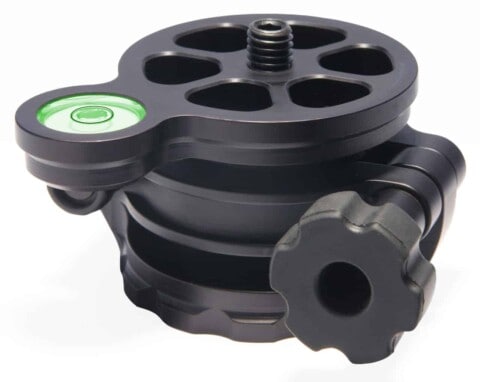
This type of head is also helpful with super-telephoto lenses with rotating tripod collars. Movement between the horizontal and vertical is controlled by rotating the lens in the collar, whilst the 2-way head handles head rotation and fore/aft tilt. It works well and is a much more compact solution compared to a large, heavy gimbal head, but the downside is that you can’t just let go of the lens; it needs to be locked tightly with the knob every time you want to take your hands away from the system.
This type of head is also helpful on a monopod when using a long lens, where a full-sized gimbal would be impractical. A knob beneath the clamp allows it to be rotated in 90-degree increments so that the clamp’s jaws can be aligned both parallel or perpendicular to the tilt axis for clamping a camera or a collared telephoto lens.
Acratech Long Lens Head
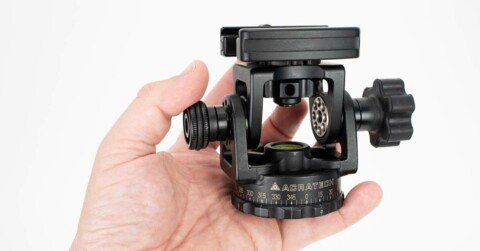
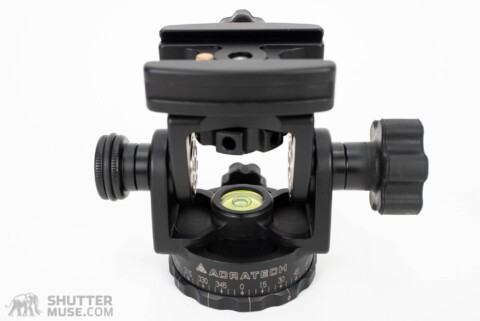
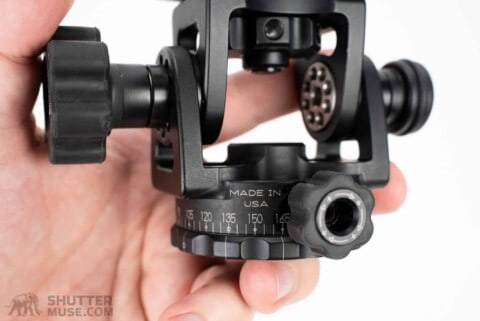
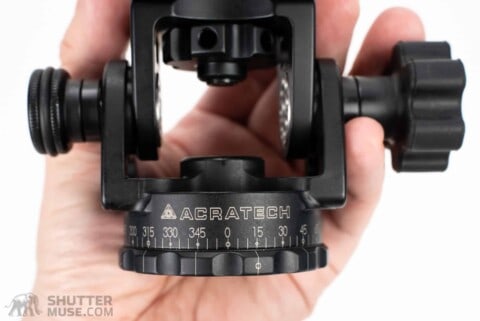
This Acratech Long Lens Head is similar to the aforementioned Panoramic Head, but if you look closely, you’ll see that it lacks the laser-etched scale on the tilt axis. This head would not be ideal for multi-row panoramas, but it has everything you’d need to use it with a long lens.
Suppose you buy the head with the “indexable clamp” option. In that case, you can quickly rotate the orientation of the clamp by 90 degrees to swap between mounting a camera via a fore/aft Arca plate on a lens collar’s foot and a plate mounted horizontally on the bottom of a camera.
Like a simpler version of the panoramic head, the Acratech Long Lens Head is cheaper, coming in at $416 with the indexable clamp. Note that the “fixed” clamp is not fixed; it just requires a hex key to loosen and rotate it, while the indexable clamp has a knob that can be loosened to facilitate the clamp’s rotation.
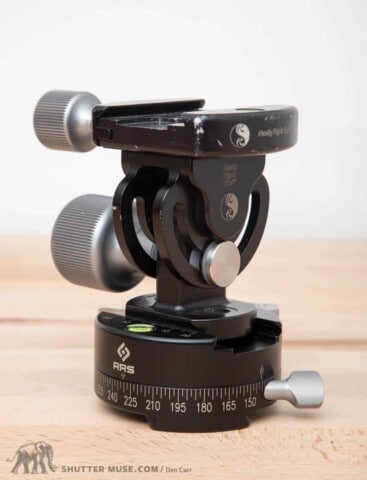
In my Really Right Stuff head guide, I mentioned a setup featuring their 2-way monopod head mounted to a panning clamp. Essentially this is the same setup as the Acratech Long Lens Head, but the Acratech one is cheaper and simpler by having the panning base built into the bottom of the tilt head. If you want to learn more about it, read my Acratceh Long Lens head review.
Discontinued Acratech Ball Heads
Acratech Spherical Panoramic Head
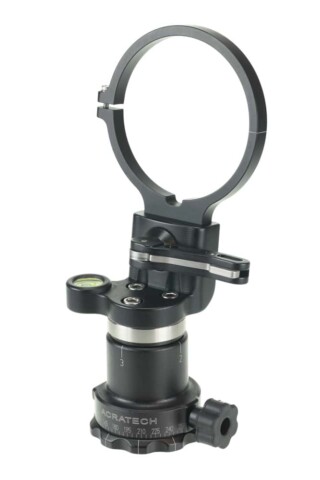
This spherical head was designed to be used by Google Maps with the Sigma 8mm fisheye lens to create 360-degree spherical panoramic images. A niche subject matter made even more niche by the Sigma-lens-specific design. It’s pretty cool! But it’s probably not for you. The head appears to have been discountinued.
The following heads appear to have been discontinued to make way for a simpler and more streamlined ball head lineup. Instead of deleting the descriptions of these heads from the guide, I’m moving them to this discontinued section for historical reference.
Acratech GP
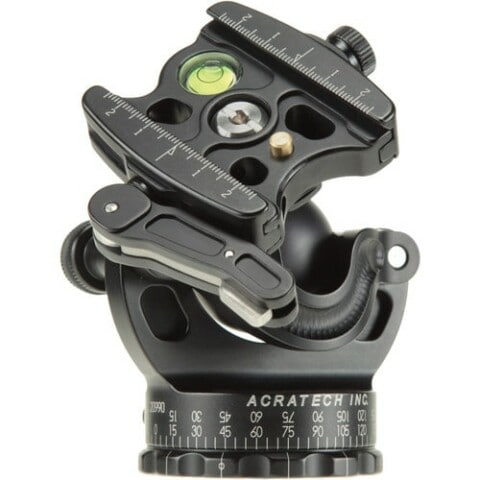
As you can see from the images, the Acratech GP is very similar to the GXP, but the specifications will show that the capacity of the head is 25lbs instead of the 50lbs of its bigger brother.
The GP has undoubtedly been a popular head over the years, but I can’t help thinking that with the launch of the GXP, few people will choose to buy the GP. The weight of the GP is almost the same as the GXP, but it lacks some of the newer features mentioned above in the GXP write-up, and of course, the overall capacity is significantly less. Even if your kit doesn’t approach a head’s capacity (who has a 50lb camera?!), any added capacity will result in a more stable platform overall.
With its smaller physical dimensions, you might think that the GP would be a compelling model for travel or smaller travel tripods, but the GPSS model is far better suited for that purpose. The GPSS has the same 25lb capacity as the GP but in a significantly smaller package.
This leaves the Acratech GP in a rather odd position in the lineup. It’s neither the smallest head nor the largest capacity, and yet it has a weight similar to the highest capacity head (GXP) and a capacity that is the same as the smallest and lightest head. It doesn’t “win” in any category, and whilst it’s a great ball head when viewed in a vacuum, I’m unlikely to recommend it to anyone when the options of the GPX and GPSS are also on the table.
Acratech GPSS
The Acratech GPSS is a small head with a significant (25lb) capacity. While the capacity is less than the GXP head, the whole head is significantly smaller, including the diameter of the base. This makes it an excellent option for travel photography with smaller travel tripods, and the lighter weight, although not that much lighter than the GXP, is still worthy of consideration on longer hikes for the more adventurous landscape photographers out there.
It’s not the smallest travel head on the market, but ball heads that are smaller than the GPSS forgo the dedicated panning base option and the separate friction control knob for the ball. Not to mention the lack of panning head and gimbal features found on this head.
Acratech Nomad
Born from the design of the older and now discontinued Acratech GV heads, the Acratech Nomad was explicitly designed to be produced by a multi-axis milling machine in Acratech’s California factory. Essentially, this means for customers that it’s easier and faster for them to make a Nomad than any of the GP heads, resulting in a significantly lower cost. This is not an insignificant difference at around $330 for the Nomad, compared to $417 for the cheapest GP head. Despite the cheaper price, the Nomad head still weighs less than 1lb and supports up to 25lbs!
While the Nomad does have the gimbal feature of the GP heads, it cannot work as a panoramic head, so this is a 2-in-1 head instead of the 3-in-1 design of the previous three heads that have been talked about. This is an excellent option if you are constricted by your budget but want to get an Acratech head. If money is less of a priority, the GP series offers better heads with more features, but it’s nice to have various options to suit different budgets.
Final Thoughts
I hope you found this guide helpful in making tripod head purchasing decisions. My pick of the lineup is the new GXP head with its incredible 50:1 capacity to weight ratio, or it’s slightly smaller sibling, the GXP-SS, but all of the Acratech models have pros that make any one of them a good buy for the proper usage. Feel free to leave questions in the comments below or comment to let me know what you think of your Acratech head.







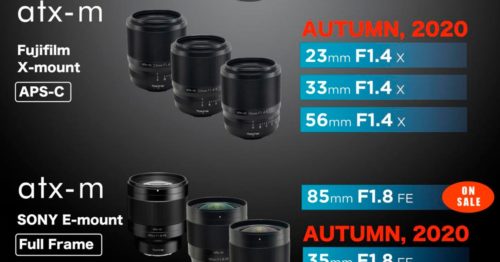
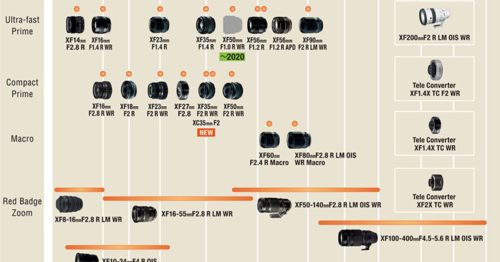
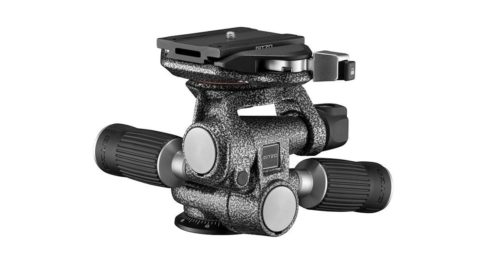
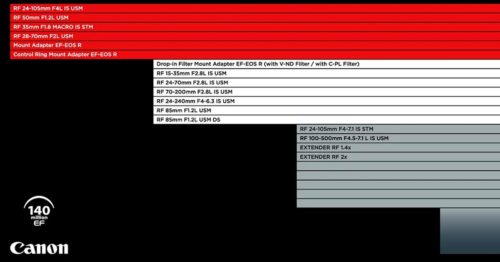

Hi Dan!
Being in Canada, I don’t have anywhere to “look at” the Acratech ballheads. Same goes for RRS. What is your advice on the comparison of the GXP vs a RRS BH55 if looking for a versatile ballhead and a system to invest in if wanting to add future components? Such as a gimble – I believe you highly recommend the RRS PG-02? Thanks in advance!
Yeah I do highly recommend the PG-02, and in terms of adding additional components to things, there’s nothing to say you can’t own an Acratech ball head and an RRS PG-02. I know some people like to find a brand and stick with them, and in that case RRS do have more products and a broader range that also includes tripods as well, but I’m personally looking forward to using an Acratech GXP on my RRS tripod.
In terms of BH-55 Vs. GXP, if you carry gear on your back a lot of the time, the GXP is going to be a great option. The BH-55 really is a big beast, and whilst I love the huge locking knob on it for gloved winter usage, I always wish it was lighter.
Depending on how big a lens you are planning to use on the gimbal, the GXP might be an all round solution for you?
Thanks for the feedback Dan! Much appreciated.
Hi Dan and thank you for reviewing the Arcatec heads. Do these heads have a feature to prevent them rotating off the tripod base similar to the Manfrotto MVH 500AH fluid head. Kind regards Ziga
I think what you are referring to is the levelling bowl on the bottom of the Manfrotto fluid head. That is not specifically designed to prevent it coming off the tripod, it’s designed to level the panning base quickly.
If you are concerned about it coming off, use some Locktite on the thread: https://shuttermuse.com/go/amazon-blue-loctite/
GREAT article, Dan! I have had the Acratech GP for years and LOVE it. The open design and the weight are fantastic. Superb quality. I bought the Pano base, which I recommend if you do a lot of panoramas. Much faster. The pano base would be a perfect match for the Nomad.
All that said, I want this new one…it looks fantastic. I can’t think of a reason to get that other “R” head (ahem) which is more expensive and heavier.
You do great gear reports. Thanks.
Thanks Patrick!
Dan, your tripod and head reviews/rundowns have been useful.
I first bought the Acratech Ultimate head, and still have it. Its main downside for me was that tightening the ball lock causes it to shift, which was a nuisance with high-magnification macro photography, one of my main uses. Other than that I really like it. (To change from downward to upward tilt, I rotate the base 180 degrees – it takes only seconds.)
So I bought an RRS BH-40 (original version). It has been a nice head, which I have used for about 10 years. In that time it has broken twice, necessitating expensive factory repair (entailing shipping to and from Canada), although I’m not hard on it and my gear is lightweight. Too fussy, and too expensive for what it is, in my experience.
Since I do a lot of backpacking and travel, where weight is a critical factor, I think I will try one of the new Acratech GP heads, for both landscape and macro work. It sounds as if the GPSS is the one for me, but I would welcome any comment on that.
Your articles have helped me to narrow down the choices. Thank you.
Hey Rich, glad to help. Yeah I think you have probably narrowed it down to the GXP and the GP-SS. If weight really is critical, the GP-SS will be a fine choice. Although the GXP does give you double the capacity for only an extra 0.15lbs… tricky one! You’ll be happy with either, so go with your gut on this one. I’m not sure how much of an ounce counter you are when it comes to hiking gear 🙂
I find it interesting that in order to use the 3-in-1 heads inverted for panos, you MUST be shooting your panos with your camera perfectly level to the ground. Any tilt at all and the system doesn’t work. This seems like a major limitation to me that is worth mentioning. A leveling base does not suffer from this limitation and thus is a much more flexible solution. An ideal version of this head would allow you to rotate both the clamp and the base, depending on the situation, and eliminate the need to invert it.
I think you are misunderstanding this, Tim. But I’m not entirely certain where the misunderstanding is.
The inverted design means you DO NOT need to level your tripod. This is the whole point of flipping it over. Otherwise, it would be no different to using the head the regular way up.
Put the tripod roughly level, then use the ball to level the camera clamp. At this point, the rotation of the clamp will be perfectly lined up with the horizon.
If you are talking about the need for the camera to be level, with the horizon line pointing through the middle of the frame, then this is a limitation of any single-row pano setup. It doesn’t matter if you’re using a levelling head or not. The only way you can shoot a perfect pano where the horizon is not centred on the middle of the frame is by using a dedicated pano head that rotates the camera forward or upward around the nodal point.
Your reviews are very comprehensive and appreciated % how do I order the camera adapter plate for my older ball head .